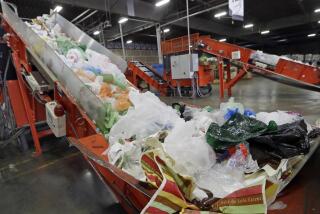PERSPECTIVE ON THE ENVIRONMENT : Fed a Line, Ronald Goes Green : McDonald’s dropped plastic foam packaging in reponse to its reading of consumer opinion, but consumers were wrong.
- Share via
As environmental concerns mount and confidence in government declines, public policy affecting the survival of the planet is increasingly being determined in the marketplace. The nation’s giant consumer-marketing companies are grappling with the question of how to make and brand “green” products.
Through elaborate sales breakdowns, consumer surveys and demographic profiles, they are closely monitoring the power of “green” appeal--with the motive of delivering goods more attuned to the concerns, attitudes and desires of Americans.
All of this sounds like progress, but there’s a catch. Marketing companies don’t create value to their shareholders by selling products that are environmentally sound; they create value by selling products that consumers who care about the environment perceive as environmentally sound. When consumers are well-informed, companies deliver sound products; when consumers are ill-informed or ignorant, but the companies may deliver bad products and policies to ill-informed or ignorant consumers. To master an area as complex as the environment, however, consumers need guidance. Government must provide that guidance by becoming an authoritative, reliable and accessible source of information--or chaos will surely ensue.
McDonald’s is a good example. A few weeks ago, responding to what it believed was the will of the people, the company announced that in 60 days it would replace polystyrene food packaging with paperboard at its U.S. restaurants.
The fact that consumers had an impact on the largest company in the fast-food industry is good news. But the consumers’ view was erroneous. Conversion to paper packaging will aggravate our burgeoning solid-waste crisis.
The Environmental Defense Fund called the firm’s decision “an environmental touchdown.” The fund had been working with McDonald’s through an unusual alliance, begun last August, to jointly explore ways to reduce, recycle or compost waste produced by the firm’s 11,000 restaurants around the world.
More than a year ago, McDonald’s established a $16-million polystyrene-recycling program at its New England restaurants. It was preparing to take the program nationwide this fall. Apparently the fund, backed by a host of environmental and grass-roots coalitions, opposed the recycling initiative (in spite of a long history of supporting recycling efforts), and threatened to condemn McDonald’s if the company persisted in its attempts to make plastics more acceptable to consumers. According to one activist, McDonald’s was “looking for ways to control the problem, not prevent and eliminate it.”
Fast-food packaging contributes only about one-third of 1% to the solid waste produced in the United States. So it hardly tops the list of problems contributing to the nation’s garbage crisis. But McDonald’s apparently believed that consumers were growing so upset with its packaging that they might switch in droves to someone else’s burgers. Its decision to change to paper packaging does not represent an improvement from an environmental perspective.
Franklin Associates Ltd., an environmental research firm, released a study this year examining the relative energy and environmental impacts of foam polystyrene and coated bleached paperboard packaging. It takes 30% less energy to produce polystyrene containers; although they contribute 29% more waste by volume than paperboard, with recycling they can contribute considerably less; they deposit 42% less water-borne waste during disposal and release roughly twice as much energy during incineration than paperboard, by weight, and burn more cleanly.
Similarly, a 1988 study by an independent research firm in Germany examined the theoretical impact of eliminating plastic packaging from the national economy. The findings were even more conclusive: Packaging materials would increase fourfold by weight without plastics, the volume of waste related to packaging would double, and energy consumed in packaging production would also double. Packaging, overall, could cost consumers about twice as much.
Environmentalists have, of course, disputed many of these findings. They argue that plastic production involves the use of chlorofluorocarbons, or CFCs, chemicals that contribute to depletion of the ozone layer. But the food industry phased out CFCs in polystyrene manufacturing in 1988.
Environmentalists argue that plastics are difficult to recycle. Industry and government, however, have gotten together across the United States to recycle not only polystyrene fast-food packaging, but also plastic soda bottles. There have been no such initiatives for recycling paperboard--in part because such packaging, including McDonald’s new containers, cannot contain recycled materials and consist of a combination of paper and plastic.
Environmentalists argue that, unlike paperboard, plastics are neither biodegradable nor photodegradable. But in modern landfills, little degrades; the lack of air and light guarantees that newspapers, carrots and hot dogs--as well as plastics--will survive for years without decay.
What McDonald’s got out of its deal, therefore, was the worst of both worlds. It found itself doing the wrong thing for the wrong reasons.
Government had a role to play here, and it failed. Consumers cannot by themselves to make sense of corporate and environmental image handlers who would bamboozle them according to myriad special-interest agendas. Government must set environmental standards, practices and definitions for areas such as recycling and incineration--preferably in the context of a long-term national plan--and then get that information to consumers. Only then will the marketplace, and companies subject to its forces, function in ways that usefully reflect the true “greenness” of American consumers.
More to Read
Inside the business of entertainment
The Wide Shot brings you news, analysis and insights on everything from streaming wars to production — and what it all means for the future.
You may occasionally receive promotional content from the Los Angeles Times.










